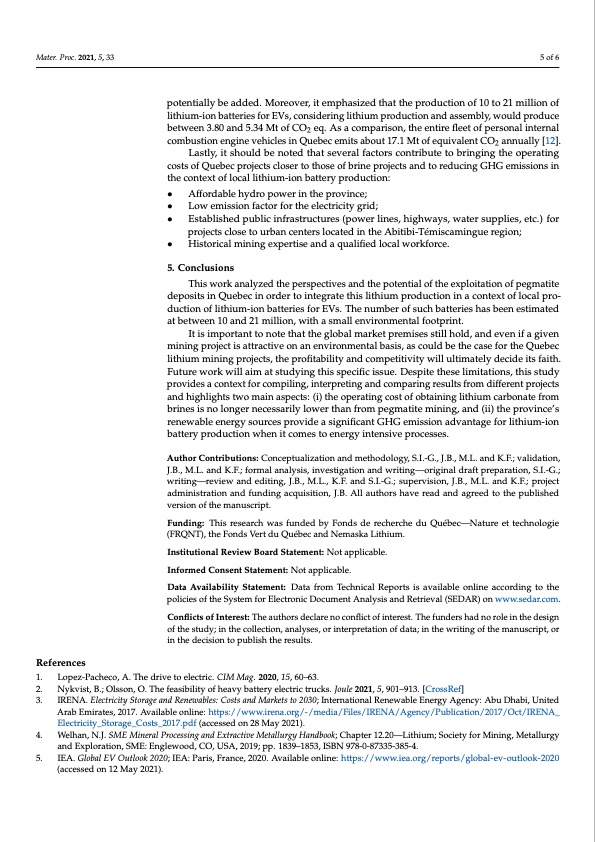
PDF Publication Title:
Text from PDF Page: 005
Mater. Proc. 2021, 5, 33 5 of 6 References potentially be added. Moreover, it emphasized that the production of 10 to 21 million of lithium-ion batteries for EVs, considering lithium production and assembly, would produce between 3.80 and 5.34 Mt of CO2 eq. As a comparison, the entire fleet of personal internal combustion engine vehicles in Quebec emits about 17.1 Mt of equivalent CO2 annually [12]. Lastly, it should be noted that several factors contribute to bringing the operating costs of Quebec projects closer to those of brine projects and to reducing GHG emissions in the context of local lithium-ion battery production: • Affordable hydro power in the province; • Low emission factor for the electricity grid; • Established public infrastructures (power lines, highways, water supplies, etc.) for projects close to urban centers located in the Abitibi-Témiscamingue region; • Historical mining expertise and a qualified local workforce. 5. Conclusions This work analyzed the perspectives and the potential of the exploitation of pegmatite deposits in Quebec in order to integrate this lithium production in a context of local pro- duction of lithium-ion batteries for EVs. The number of such batteries has been estimated at between 10 and 21 million, with a small environmental footprint. It is important to note that the global market premises still hold, and even if a given mining project is attractive on an environmental basis, as could be the case for the Quebec lithium mining projects, the profitability and competitivity will ultimately decide its faith. Future work will aim at studying this specific issue. Despite these limitations, this study provides a context for compiling, interpreting and comparing results from different projects and highlights two main aspects: (i) the operating cost of obtaining lithium carbonate from brines is no longer necessarily lower than from pegmatite mining, and (ii) the province’s renewable energy sources provide a significant GHG emission advantage for lithium-ion battery production when it comes to energy intensive processes. Author Contributions: Conceptualization and methodology, S.I.-G., J.B., M.L. and K.F.; validation, J.B., M.L. and K.F.; formal analysis, investigation and writing—original draft preparation, S.I.-G.; writing—review and editing, J.B., M.L., K.F. and S.I.-G.; supervision, J.B., M.L. and K.F.; project administration and funding acquisition, J.B. All authors have read and agreed to the published version of the manuscript. Funding: This research was funded by Fonds de recherche du Québec—Nature et technologie (FRQNT), the Fonds Vert du Québec and Nemaska Lithium. Institutional Review Board Statement: Not applicable. Informed Consent Statement: Not applicable. Data Availability Statement: Data from Technical Reports is available online according to the policies of the System for Electronic Document Analysis and Retrieval (SEDAR) on www.sedar.com. Conflicts of Interest: The authors declare no conflict of interest. The funders had no role in the design of the study; in the collection, analyses, or interpretation of data; in the writing of the manuscript, or in the decision to publish the results. 1. Lopez-Pacheco, A. The drive to electric. CIM Mag. 2020, 15, 60–63. 2. Nykvist, B.; Olsson, O. The feasibility of heavy battery electric trucks. Joule 2021, 5, 901–913. [CrossRef] 3. IRENA. Electricity Storage and Renewables: Costs and Markets to 2030; International Renewable Energy Agency: Abu Dhabi, United Arab Emirates, 2017. Available online: https://www.irena.org/-/media/Files/IRENA/Agency/Publication/2017/Oct/IRENA_ Electricity_Storage_Costs_2017.pdf (accessed on 28 May 2021). 4. Welhan, N.J. SME Mineral Processing and Extractive Metallurgy Handbook; Chapter 12.20—Lithium; Society for Mining, Metallurgy and Exploration, SME: Englewood, CO, USA, 2019; pp. 1839–1853, ISBN 978-0-87335-385-4. 5. IEA. Global EV Outlook 2020; IEA: Paris, France, 2020. Available online: https://www.iea.org/reports/global-ev-outlook-2020 (accessed on 12 May 2021).PDF Image | Perspectives of Lithium Mining in Quebec

PDF Search Title:
Perspectives of Lithium Mining in QuebecOriginal File Name Searched:
materproc-05-00033.pdfDIY PDF Search: Google It | Yahoo | Bing
Product and Development Focus for Infinity Turbine
ORC Waste Heat Turbine and ORC System Build Plans: All turbine plans are $10,000 each. This allows you to build a system and then consider licensing for production after you have completed and tested a unit.Redox Flow Battery Technology: With the advent of the new USA tax credits for producing and selling batteries ($35/kW) we are focussing on a simple flow battery using shipping containers as the modular electrolyte storage units with tax credits up to $140,000 per system. Our main focus is on the salt battery. This battery can be used for both thermal and electrical storage applications. We call it the Cogeneration Battery or Cogen Battery. One project is converting salt (brine) based water conditioners to simultaneously produce power. In addition, there are many opportunities to extract Lithium from brine (salt lakes, groundwater, and producer water).Salt water or brine are huge sources for lithium. Most of the worlds lithium is acquired from a brine source. It's even in seawater in a low concentration. Brine is also a byproduct of huge powerplants, which can now use that as an electrolyte and a huge flow battery (which allows storage at the source).We welcome any business and equipment inquiries, as well as licensing our turbines for manufacturing.| CONTACT TEL: 608-238-6001 Email: greg@infinityturbine.com | RSS | AMP |